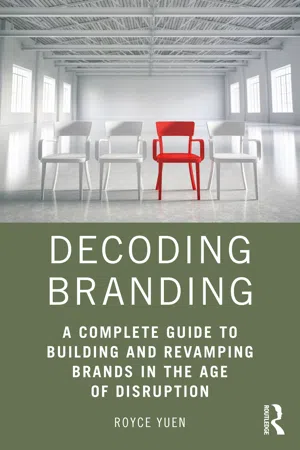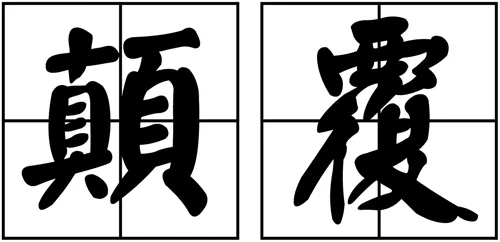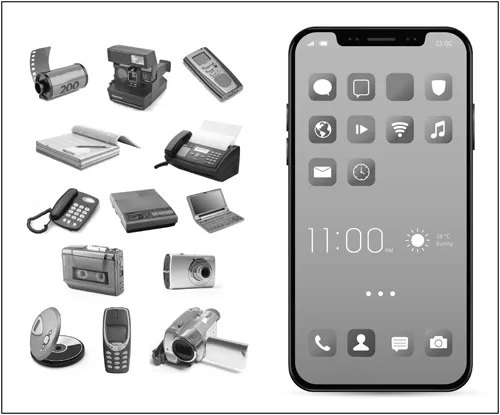
eBook - ePub
Decoding Branding
A Complete Guide to Building and Revamping Brands in the Age of Disruption
This is a test
- 234 pages
- English
- ePUB (mobile friendly)
- Available on iOS & Android
eBook - ePub
Decoding Branding
A Complete Guide to Building and Revamping Brands in the Age of Disruption
Book details
Book preview
Table of contents
Citations
About This Book
Decoding Branding explains the evolution of branding and how the disrupting factors like digital revolution, technological advancement, changing consumer behavior, and the COVID-19 pandemic have reshaped the marketing landscape. Fundamental principles of fostering strong brands are distilled with illustrations of case studies from various industries. A structured and holistic framework to building and revamping brands is clearly presented for corporations to remain competitive in this constantly changing operating environment. Interviews with branding experts and corporate leaders are featured at the end of each chapter to allow readers to obtain a complete appreciation of brand development from different perspectives.
Frequently asked questions
At the moment all of our mobile-responsive ePub books are available to download via the app. Most of our PDFs are also available to download and we're working on making the final remaining ones downloadable now. Learn more here.
Both plans give you full access to the library and all of Perlego’s features. The only differences are the price and subscription period: With the annual plan you’ll save around 30% compared to 12 months on the monthly plan.
We are an online textbook subscription service, where you can get access to an entire online library for less than the price of a single book per month. With over 1 million books across 1000+ topics, we’ve got you covered! Learn more here.
Look out for the read-aloud symbol on your next book to see if you can listen to it. The read-aloud tool reads text aloud for you, highlighting the text as it is being read. You can pause it, speed it up and slow it down. Learn more here.
Yes, you can access Decoding Branding by Royce Yuen in PDF and/or ePUB format, as well as other popular books in Business & Business General. We have over one million books available in our catalogue for you to explore.
1
Welcome to the Age of “Disruption”
Disruption, as a word, is not new to the dictionary.
But the way it is used to describe the rapid and unprecedented reshaping of the marketplace has given the word novel and profound implications.
According to the Merriam-Webster Dictionary, “disruption” is defined as “the act or process of disrupting something: a break or interruption in the normal course or continuation of some activity, process, etc.” 1 This definition may suggest that disruption is bad and undesirable because it interrupts a current state of being. Yet if the so-called destruction of the current way of doing things is leading (or forcing) us to come up with more innovative or simply more sensible ways of performing our work, then disruption is not necessarily a dreadfully evil force.
It is interesting to note that the Wikipedia page for “disruption” does not list a single explanation of what the word means. Instead, the site enumerates a range of concepts and phenomena that are associated with disruption, ranging from biological cell disruption to the Disruption of 1843 that divided the Church of Scotland. Of the many disruptions listed on Wikipedia, two are of particular interest to this book:
- “Disruptive Innovation”: a term coined by Clayton Christensen, disruptive innovation is a process by which simple and accessible products that start at the bottom of the market can eventually threaten established companies, moving upmarket relentlessly to meet the needs of mainstream customers. 2
- “Creative disruption”: introduced in 1992 by TBWA’s chairman Jean-Marie Dru, creative disruption is an approach, and more so a mindset, for overturning cultural and market conventions so that future trends can be identified and leveraged in branding. 3
The Chinese term that is commonly used by businesses today to mean “disruption” is diān fù, which further emphasizes the business implications behind the word (Image 1.1).

According to Baidu, the most popular search engine in China, “disruption” means to “overthrow” the status quo by causing substantial change to the structural and fundamental nature of things. 4
Threat or opportunity?
By taking all of the above definitions into account, we can arrive at a more complete assessment of the term “disruption” that helps us think about businesses across culture and time:
- Disruption is likely provoked by market players with the ambition to re-define the category.
- These players may not be, and usually are not, the traditional blue chips but instead more nimble outfits that are free of any baggage or legacy.
- Technology has been a catalyst that empowers these setups to do things drastically differently.
- Creativity fuels this revolution and provides the spark for numerous chain reactions.
- Those who are complacent about their past achievements perceive disruption as a negative force that interrupts existing industry practices or threatens their current market position.
- Yet those who embrace or spearhead change quickly recognize the positive effect of disruption, and see that genuinely “nothing is impossible.”
“Change Management” as a concept has been substantially researched and written about over the past few decades. Perhaps Peter Drucker put it best when he said, “If you want something new, you have to stop doing something old.” 5 The point is, if we don’t do something new, our competitors will. In fact, consumers are constantly, either consciously or subconsciously, looking for something new. To them, “new” does not only mean current or up-to-date. “Being new” is about being “easier to use,” “more entertaining,” “higher performing,” “more understanding,” “better valued,” and of course more “trendy” and “cool.” It is worth revisiting the words of Jack Welch, former chairman and CEO of General Electric, who observed that “if the rate of change on the outside exceeds the rate of change on the inside, the end is near.” 6 This book will present cases that illustrate how the changing expectations of Netizens and the current state of competition are influencing the market. Indeed, those who drive disruption do so not only to disrupt, but also to survive.
Today’s millennials may not have seen or heard of the following items that were once popular and even essential in their parents’ or grandparents’ day – roll film, yellow pages, facsimile, Walkman, Discman, instant camera, electronic translator, voice-recorder, etc. (Image 1.2). All these products were designed to perform one function and have been completely replaced by the smartphone, which can perform all of the above and more. It is brutal when products or even industries are totally wiped out, erased, and forgotten. That’s why brands have to step up and be more than just functional brands by offering something more substantial and intimate to consumers.

The digital revolution and purpose-driven marketing
The Internet is now, without a doubt, part of our everyday lives. It has changed the way we work, learn, play, shop, and interact. The Internet first emerged in the 1960s and was originally an initiative to enhance military capabilities. It became widely deployed in the commercial sector in the 1980s but didn’t initially cause a market disruption. It was not until fiber optics and the increasing penetration of mobile devices enhanced the global network infrastructure that a paradigm shift occurred. Now, massive data can be transmitted at high speed, processed, and stored with cloud computing. A window of opportunity has opened for smaller players to compete with business “goliaths,” not by “size and scale” but through “innovation and intelligence.”
Yet this is not the first time that something new and revolutionary has happened to mankind. The invention of the radio and television also drastically changed the way we live and perform marketing. So why and how did the digital revolution cause such an unprecedented disruption? The answer is simple. Both radio and television are media that merely serve as carriers of information and commercial messages. Audiences turn on the radio and television to consume news or entertainment but are inevitably and involuntarily exposed to advertisers’ sponsored messages. In that sense, radios and televisions are not so different from print media or the billboards we drive past on the road.
The Internet, on the other hand, is much more than a one-way medium. Although it does serve as an advertising medium, people also go online to obtain information, exchange views, shop, and write reviews. Thanks to social networking platforms such as Facebook, YouTube, Pinterest, Instagram, LinkedIn, and TikTok, people can upload posts, photos, and videos anytime and anywhere. These platforms are the tipping points of disruption that enable consumers to truly call the shots. As we will see in later chapters, a trending topic on Twitter or a viral Instagram post can make or break even the most sizable corporation in the world. Netizens are so influential that Time Magazine awarded “Person of The Year” in 2006 to “YOU – the users of the Information Age.” 7
If Time Magazine is going to give Netizens the same award again, it will have to change the picture on its front page from a PC to a smart device. After all, the first generation of the iPhone was launched one year after the Netizens were named Person of the Year. Nowadays, consumers do not only rely on mobile apps to perform their daily tasks – they themselves are becoming more mobile. As Philip Kotler, Hermawan Kartajaya, and Iwan Setiawan explain in Marketing 4.0, new consumers tend to move around often, live life at a faster pace, and prioritize immediacy. To effectively engage these consumers, marketers must transition from the traditional four Ps to the four Cs: 8
- Co-creation, a process that invites customers into the ideation stage of product development, allowing the target audience to customize services according to individual tastes;
- Currency, whereby retailers use big-data analytics to implement dynamic pricing based on market demand and consumer buying habits;
- Communal activation, in the form of peer-to-peer marketing campaigns that attract new consumers through a wide yet personal distribution network;
- Conversation, encouraged by social media platforms that create a space for brands to communicate with consumers, and for consumers to share their reviews of brands. 9
The notion of migrating the marketing mindset from the four Ps to the four Cs recognizes and leverages the power of consumers in the digital age. In fact, there is no doubt that being consumer-centric is paramount for any commercial organization or even non-governmental organization (NGO). As Professor Theodore Levitt put it in his classic marketing book Marketing Imagination (1983), “the purpose of a business is to get and keep a customer.” 10
The difference is that in today’s marketplace, enterprises should focus on much more than customer conversion and retention. They must be aware of and hopefully manage to steer the influence that one customer can have on a possibly uncountable number of customers and prospects. A single person may have a restricted sphere of influence in the physical world yet be hugely influential in the virtual world. Even if their network is limited, a single comment can be seen by someone who can then reach hundreds of thousands of followers.
In September 2004, a blogger posted a video on YouTube demonstrating how quickly and easily Kryptonite’s Evolution 2000 bicycle lock could be compromised by only a few twists of a Bic pen. This revelation cost the company an estimated USD 10 million in just 10 days as Kryptonite scrambled to replace bicycle locks through a free exchange program. 11 The damage could have been far more severe, however, since the video directly challenged K...
Table of contents
- Cover
- Half-Title
- Title
- Copyright
- Dedication
- Contents
- List of figures
- Foreword
- Preface
- Acknowledgments
- A note from my daughters
- 1 Welcome to the Age of “Disruption”
- 2 Connecting a disconnected world
- 3 Essence of branding
- 4 The rise of disruptive brands
- 5 Branding redefined
- 6 The 10 Cs of Sustainable Branding
- 7 From micro to macro analysis
- 8 From staying in tune to staying in touch
- 9 From customer to competitive analysis
- 10 From role to customer to role to society
- 11 The 4E Brand Management Process
- Conclusion: The magic and logic of branding
- Appendix I: List of key branding principles
- Index